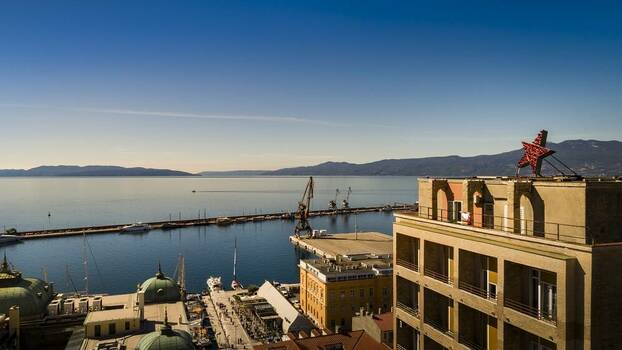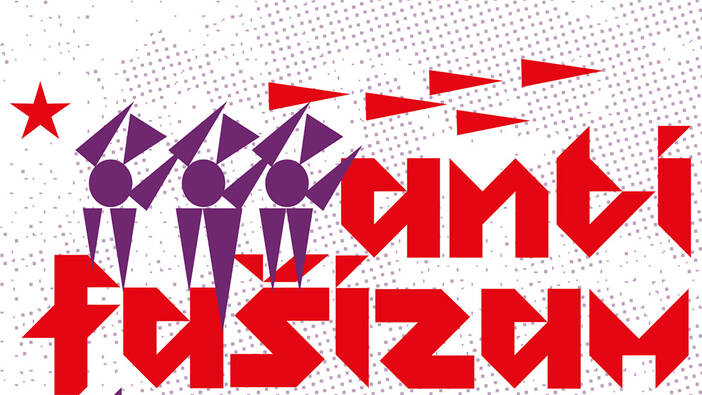
We know well from historical experiences, as well as our current lived ones, that public space is produced through a certain social practice. Once, in socialist Yugoslavia, it was a domain for the social common good, while now it represents a commodified space of the neoliberal markets in the separate states that were created on the territory of the Socialist Federal Republic of Yugoslavia through the restoration of capitalism. Thus, this space does not exist outside of society, but is a space where different ideas fight for hegemony — various groups aim to define and put public space to use in their interest.
Artan Sadiku is a Skopje-based researcher, theorist, and activist, and a regular contributor to publications such as Le Monde Diplomatique, Identities, and Bilten.
This article is based on his presentation at the fifty-ninth October Salon entitled “The Meaning of Symbols of Artistic Interventions in Public Space Today”, held in Belgrade on 22 October 2022 with support from the Rosa Luxemburg Foundation’s Southeast Europe Office.
The act of using public space for artistic interventions is itself an act of political engagement with forces present in contemporary social life, which are a result of the three decades of ideological transformation of the post-Yugoslav space. These interventions also legitimize public space as one that is to be used for social and political contestation rather than the current pressures on it towards privatization, enclosure, and commercialization that drove the liberal economic transformation. The presence of artistic interventions in public space is important for activist groups and communities in the Balkans to be able to present a counter-practice to the one of the capitalist market.
Rijeka’s Red Star
The current social and ideological context which largely determines the “dominant ideas” concerning the use of the public spaces also determines the impact and value of the artistic interventions in those spaces. Nemanja Cvijanovic’s “Monument to Red Rijeka — The Self-Defensive Monument” is a partisan red star consisting of 2,800 shards of red glass, reminiscent of the 2,800 fallen partisan fighters in the Battle of Rijeka, which anywhere in the post-Yugoslav space acts an immediate and unmistakeable reference to the antifascist struggle of World War II. Who would have thought that a symbol of a noble struggle for liberation from fascist genocide and terror, put on top of a Rijeka skyscraper, would have such s strong impact in the current public space in which it is exposed?
Politicians, state representatives, media, and various political and para-political groups in Croatia rushed to denounce this work of art and the artist himself. These reactions signal that the public space’s use, in the three decades after the breakup of socialist Yugoslavia, has been completely transformed into a space that is alien to the values which once were at the core of those societies.
This transformation is a result of the post-Yugoslav politics of ethnocentric nation-building, about which Rastko Mocnik rightfully asked in the 1990s, “How much fascism?” was to be featured in the newly created republics. Today, we get an answer to this question in the reactions to the red star intervention in Rijeka, a city traditionally considered left-wing — too much to be left alone.
The Yugoslav Legacy
After the reactions to Nemanja’s intervention in Rijeka, we can no longer ignore what is going on with the public spaces in our towns and with the dominant discourses in our societies. This context is not only a result of local revisionists, old and new nationalist politics, and far-right groups, but also very much under the influence of the European Union — the structure that was created after the victory against fascism.
While right-wingers all the more openly deny antifascist legacies, liberals, on the other hand, under the European drive towards anti-totalitarianism, equate antifascism with the Stalinist experience and abandon its symbols, meaning, and finally its historic and present value. It is in this very specific experience from Rijeka that we understand the importance and value of artistic interventions in public spaces today, especially in the Balkans, where new socialist states were built precisely on the values of antifascism and internationalism.
These interventions inform us on the politics of the day, but also perform politics of their own — the red star confronts the growing (post-)fascist narratives in Balkan societies and serves as a calling to social action and practice in defending the values of antifascism, internationalism, and solidarity, which, more than anywhere else in Europe, constitute the main emancipatory and progressive, historical, and political heritage of these societies.
Nemanja Cvijanovic’s most recent work, entitled “The Betrayal of a Better Future” and exhibited in Belgrade in the framework of the October Salon 2022, features a textual intervention on the well-known building of the “Borba” (Struggle) media house. Below the existing letters, Nemanja adds the writing “This is not a class one”.
In our discussion held at the Borba building on 22 October, Nemanja explained that he was motivated by the public artistic intervention in 1976 at the Belgrade Student Cultural Centre (SKC) by the Zagreb conceptual artist Zeljko Jerman. This artwork was a writing of the text “This is not my world” on the side of the SKC building, which the organizers of the exhibition removed a few days later. Public space in socialist Yugoslavia could not tolerate such strong political statements, because the official politics at that time considered the country to be on the path towards a better world.
Differing from the Soviet experience, socialism in Yugoslavia was an open process in which different models were tried and experimented with — workers’ self-management, cultural openness, social critique, institutional and constitutional reforms, etc. In this sense, we can claim that Yugoslavia effectively never claimed a definite end of the class struggle — the process was not closed, and never declared the end of history. To deploy the symbol of class struggle today through artistic interventions in public space is an act of struggle against the currently declared end of history, against the neoliberal capitalist deadlock.
Art as Political Practice
The class struggle today represents probably the most precious value in post-Yugoslav societies, which are being economically, environmentally, psychologically, and physically degraded in the name of profit for few obscure businessmen whose dangerous ideas shape global politics in order to accumulate even more senseless wealth. The values of Nemanja’s symbolic “class struggle” in the public space in Belgrade — one of the most capitalistically “developed” capitals of the post-Yugoslav space — stand in direct opposition to history ending up in the hands of the global and local one percent.
Are these contemporary public artistic interventions enough to initiate a change in our context today? Not, of course, on their own. Sometimes they motivate certain actions, giving rise to new movements, and sometimes they follow the actions of other groups, giving voice and visibility to movements that lack them.
Yet these should always be connected to a certain social practice, so that the interventions and practice can re-shape the public space to more egalitarian, emancipatory causes in opposition to those of nationalism, exploitation, and war. In such a practice, we will likely experience the dissolution of the specificity of art in public space as something different from the social practice it references, or for which it is a reference.
At this point, we can see these two contemporary artworks by Nemanja as social practice of antifascism and class struggle in the public space. As one of the most engaged artists in the region, Nemanja is also a political activist working with workers’ unions and socialist political groups in Croatia. This is undoubtedly one example of the dissolution of art into the social practice for which it exists. Without this practice, art in public space would remain a mere ornamental element, thus not even art.
Nemanja’s intervention and the subsequent debates that it still generates inspired the new volume Antifascism as the Self-Defensive Monument, published by the Rosa Luxemburg Foundation Southeast Europe, the Museum of Modern and Contemporary Art in Rijeka, and Piran Coastal Galleries. Edited by Vladan Jeremic and Tevž Logar, the volume gathers a series of texts by renowned local and international authors that reflect on the state of antifascism today in the post-Yugoslav space, but also Europe and beyond, including Ivana Bago, Gal Kirn, Michał Kozłowski, Dragan Markovina, Katarina Peović, Srećko Pulig, and Stefano Taccone.
